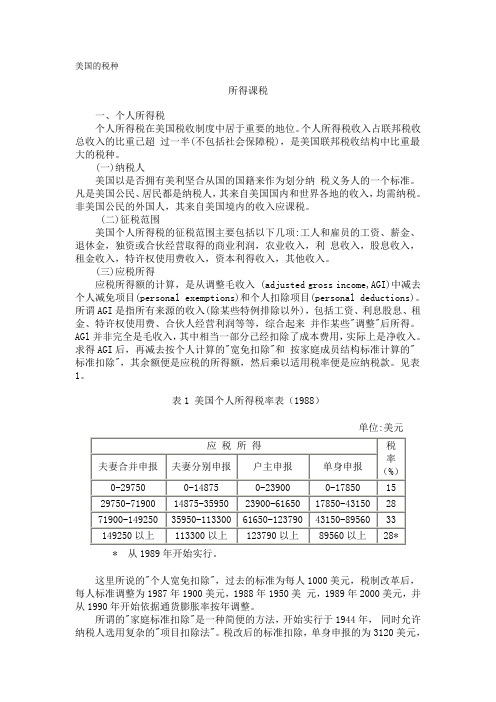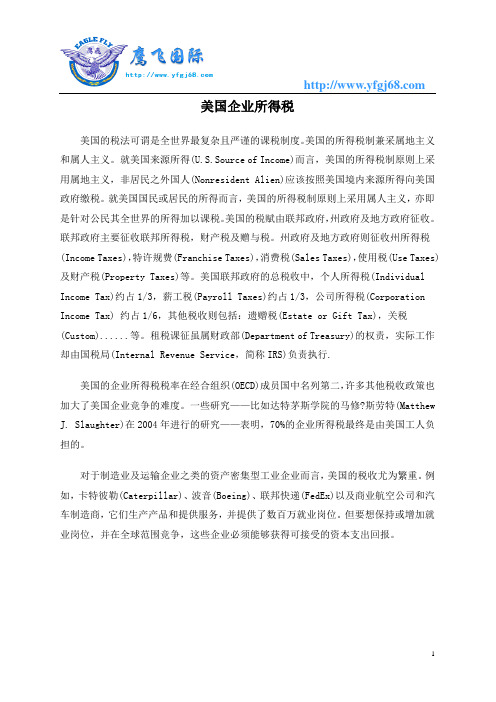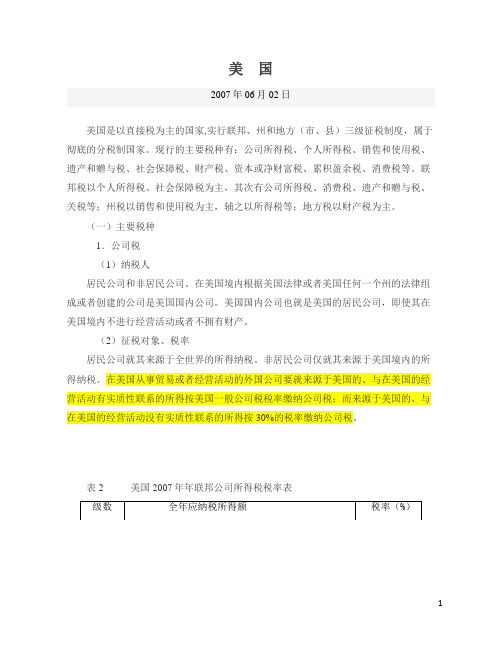美国公司所得税
美国税种简介

美国税种简介在我国目前税制改革的大背景下, 通过对美国现行税种的了解,对我国的税改会有所裨益。
标签:美国税种概况税收制度是一个课税主体下的各种税收组织体系,是国家按法律程序规定的征税依据和规范。
不同的国家或同一国家在不同的历史时期,由于社会经济状况、政治制度的不同,税收制度的内容不尽相同,但均可相互借鉴。
一、个人所得税美国个人所得税分为联邦个人所得税、州个人所得税和地方个人所得税,其中,以联邦个人所得税为主,是美国的第一大税种。
1.纳税人:个人所得税的纳税人为美国公民、居民和非居民。
美国公民是指出生在美国的人和加入美国国籍的人。
美国居民指非美国公民,但按美国移民法拥有法律认可的永久居住权(如获得绿卡)的人,不符合美国公民和居民身份的为非居民。
2.课税对象、税率:个人所得税的课税对象是美国公民和居民来源于全球的所得,美国非居民来源于境内的所得。
包括:工资薪金、经营利润、财产利得、股息红利、租金利息、特许权收入。
3.应纳税所得额与应纳税额的计算。
计算步骤:各纳税人的全部所得先减去不予计列所得(为总所得),然后减去税法规定的应在“调整所得前扣减的项目”(为调整所得),再减去分项扣减款项或标准扣减款项,再减去免税项目(为应纳税所得额),乘以适用税率(为应纳税额),最后减去税收抵免税款和已付税款等,即为最终的应纳税款。
二、工薪税工薪税亦称“社会保险税”,是联邦政府为社会保障制度筹措资金而课征的一种税,它的征收对象是纳税人的工薪收入和经营收入。
美国的社会保障制度开始于罗斯福“新政”时期的1935年的“社会保障法案”,最初只包括“老年与遗属保险”,简称OASI,以薪工税筹措老年人的退休金。
此外,该法案还制定了联邦和州系统的失业保险制度。
后来,由于保险救济金水平,以及应纳税的工薪收入额不断增加,1956年增加了“伤残人保险”,二者合称为OASDI。
1966年又增加了“医疗保险”,它是为65岁以上老年人提供的“住院保险”和“医药保险”,与OASDI 合称为OASDHI。
外国税制概述

外国税制概述外国税制概述税收是国家财政的重要组成部分,也是国家治理的重要手段之一。
不同国家的税制有着不同的特点和规定,本文将对外国税制进行概述。
一、美国税制美国税制是以联邦政府为主导,各州和地方政府为辅助的联邦制税制。
美国的税种繁多,包括个人所得税、企业所得税、消费税、财产税等。
其中,个人所得税是最主要的税种之一,税率根据收入水平分为不同档次,最高税率为37%。
企业所得税税率为21%,消费税则由各州自行决定。
二、日本税制日本税制是以中央政府为主导,地方政府为辅助的集中制税制。
日本的税种包括个人所得税、企业所得税、消费税、财产税等。
其中,消费税是最主要的税种之一,税率为10%。
个人所得税税率根据收入水平分为不同档次,最高税率为45%。
企业所得税税率为30.86%。
三、德国税制德国税制是以联邦政府和各州政府共同管理的联邦制税制。
德国的税种包括个人所得税、企业所得税、增值税、财产税等。
其中,增值税是最主要的税种之一,税率为19%。
个人所得税税率根据收入水平分为不同档次,最高税率为42%。
企业所得税税率为15%。
四、英国税制英国税制是以中央政府为主导,地方政府为辅助的集中制税制。
英国的税种包括个人所得税、企业所得税、增值税、财产税等。
其中,个人所得税是最主要的税种之一,税率根据收入水平分为不同档次,最高税率为45%。
企业所得税税率为19%,增值税税率为20%。
总体来说,不同国家的税制有着不同的特点和规定,但都是为了维护国家财政和社会公共利益而设立的。
在全球化的今天,各国税制的相互影响和互动越来越密切,税收合作也越来越重要。
移民美国的三大税种介绍

【导语】在美国,个⼈所得税是最主要的税种,个税的对象是美国公民和居民。
美国个⼈所得税分为联邦个⼈所得税、州个⼈所得税和地⽅个⼈所得税。
以下是整理的移民美国的三⼤税种介绍,欢迎阅读!1.移民美国的三⼤税种介绍 美国第⼆⼤税种是社会保障税,占税收总额的35%左右,第三⼤税种是公司所得税,占税收总额的10%左右。
美国个税在整个财政收⼊中所占⽐重不断上升,也体现了美国以直接税为主体的特征。
美国公民和绿卡持有者,⽆论在不在美国居住,或出⼊境美国多少次,都需要向美国申报个⼈所得税。
在我国,税收收⼊中只有6%来⾃个⼈所得税。
1、个⼈所得税 美国个税为表现公平性,也是综合征收,个⼈宽免额、基本扣除和涉及教育、⼦⼥、赡养等专项优惠扣除美国都有。
这⾥想说的是,美国个税不是到了年度终了后才综合来申报,⽽是平时个⼈取得收⼊就扣税缴税,⽽且平时缴的还相对多,因为平时没有那么多的优惠扣除。
到了年度终了后税务部门才会综合统筹考虑全年度的优惠扣除,年底就会有退税,这样到年底纳税⼈就会积极乐意的去申报。
这是⼀种激励⽅法。
像残疾⼈啊、有家庭⼈⼝负担的情况啊,都会多扣,到年度终了后都会被统筹考虑⽽得到退税。
2、替代最低税 联邦个⼈所得税体系中有替代最低税是为确保富⼈不因为利⽤各种税务优惠⽽导致税负很轻。
因此,要求⾼收⼊群体按照正常⽅法和替代最低税法分别计算应纳税额,并取其较⾼者作为应纳税额。
3、新移民接受赠予 初期没⼯作的新移民如果是依靠原居住地亲友寄赠⽣活费,按规定,国外亲友赠予免征税,但是,亲友寄赠的⽣活费如超过10万美元,年度报税时,要以3520税表申报,才不会被视为收⼊。
税务表格可以在美国⼤使馆/领事馆取得。
汇款时通过银⾏电汇,保留汇款单据,以备国税局查账时作为证明。
美国居民在国外⼯作所得,凡87600美元以下国外薪资所得部分,享免课税优惠,可⽤2550税表申报。
2.美国移民的好处 1.失业救济 当申请⼈、配偶甚⾄⼦⼥在办理绿卡后⽆法⼯作时,政府将为您提供免费的求职服务。
美国的税种

美国的税种所得课税一、个人所得税个人所得税在美国税收制度中居于重要的地位。
个人所得税收入占联邦税收总收入的比重已超过一半(不包括社会保障税),是美国联邦税收结构中比重最大的税种。
(一)纳税人美国以是否拥有美利坚合从国的国籍来作为划分纳税义务人的一个标准。
凡是美国公民、居民都是纳税人,其来自美国国内和世界各地的收入,均需纳税。
非美国公民的外国人,其来自美国境内的收入应课税。
(二)征税范围美国个人所得税的征税范围主要包括以下几项:工人和雇员的工资、薪金、退休金,独资或合伙经营取得的商业利润,农业收入,利息收入,股息收入,租金收入,特许权使用费收入,资本利得收入,其他收入。
(三)应税所得应税所得额的计算,是从调整毛收入 (adjusted gross income,AGI)中减去个人减免项目(personal exemptions)和个人扣除项目(personal deductions)。
所谓AGI是指所有来源的收入(除某些特例排除以外),包括工资、利息股息、租金、特许权使用费、合伙人经营利润等等,综合起来并作某些"调整"后所得。
AGl并非完全是毛收入,其中相当一部分己经扣除了成本费用,实际上是净收入。
求得AGI后,再减去按个人计算的"宽免扣除"和按家庭成员结构标准计算的"标准扣除",其余额便是应税的所得额,然后乘以适用税率便是应纳税款。
见表1。
表1 美国个人所得税率表(1988)单位:美元* 从1989年开始实行。
这里所说的"个人宽免扣除",过去的标准为每人1000美元,税制改革后,每人标准调整为1987年1900美元,1988年1950美元,1989年2000美元,并从1990年开始依据通货膨胀率按年调整。
所谓的"家庭标准扣除"是一种简便的方法,开始实行于1944年,同时允许纳税人选用复杂的"项目扣除法"。
美国税收政策

美国税收制度美国是我国“走出去”企业主要投资目的地国家之一,因其优越的经济环境、领先的技术水平及包括税收优惠政策在内的政府优惠政策而受到我国投资者的青睐。
为帮助“走出去”企业了解美国税制、做好投资前后的税收因素分析和税收风险控制,掌握税收争议解决的有效途径,深圳地税局“走出去”税收沙龙以“投资美国税务风险控制”为主题进行了专题讨论。
一、美国税制简况美国实行由联邦、州和地方分别立法及征管,联邦以所得税、州和地方以销售税和财产税为主体的税收制度。
联邦税包括所得税、预提所得税、雇佣税、贸易及海关税收;州和地方税包括所得税、特许(权)税、销售和使用税、财产税。
美国的所得税分为公司收入所得税及个人收入所得税。
公司联邦收入所得税采用累进税率制,实行15%至38%的累进税率,在计算公司联邦收入所得税时,净营业损失与资本利得损失分别计算,净营业损失可向前追溯2个纳税年度向后结转20个纳税年度、净资本利得损失可向前追溯3个纳税年度向后结转5个纳税年度。
个人收入所得税是联邦政府税收主要来源,个人收入所得税的缴付方式包括夫妻联合报税、夫妻分别报税、以家庭户主形式报税和单身个人保税四种,采取累进税率制。
雇佣税主要包括社会保险、医疗保险及联邦失业保险税和州政府失业税。
当美国公司或自然人向非美国人(包括非美国公司、非美国合伙企业和非美国自然人)支付来源于美国的服务费、利息、股息、租金、特许权使用费、养老金及其他与业务无关的报酬时要代扣代缴美国联邦税负,即缴纳报酬总额30%的预提所得税,在符合中美税收协定的条件下可享受协定议定的实际税率。
美国各州有权自行制定税收制度,可根据所在州立法机构制定的有关法律和经济发展水平等设立不同的税种和相关税率,因此美国各州的税收制度比联邦税收制度更加多样化。
在计算联邦所得税时,州和地方的所得税可以进行扣除,有些州如内华达州、南达科他州、怀俄明州等免征州公司收入所得税,各州为扩大就业水平、引导投资方向均推出针对公司实体的投资鼓励政策,鼓励和欢迎无污染或较少污染、投资金额大、科技含量高、能提供就业带动经济发展的公司投资,给予相应的税收优惠。
美国 GAAP 下的企业所得税会计处理与案例分析

美国 GAAP 下的企业所得税会计处理与案例分析在美国的企业会计准则(GAAP)框架下,企业所得税是一项重要的会计处理事项。
企业所得税的计算和处理涉及到多种因素和规定,需要企业遵循相关准则和规范来确保准确和合规性。
本文将对美国GAAP 下的企业所得税会计处理进行详细分析,并通过案例分析帮助读者更好地理解和应用相关准则。
一、美国 GAAP 下的企业所得税会计处理概述1.1 企业所得税的定义与影响因素企业所得税是指企业根据税法规定需要缴纳的税款。
它的计算基于企业的利润和应纳税所得额,同时还受到税法规定的税率以及各种税收抵扣和减免的影响。
1.2 企业所得税的会计处理方法根据美国 GAAP,企业所得税的会计处理主要分为两个方面:一是当前税项的会计处理,即当期应交的企业所得税;二是递延税款的会计处理,即企业未来某个会计期间需进行的税项处理。
二、当前企业所得税会计处理2.1 当前企业所得税的计提企业在每个会计期末,需要根据当期利润计算出应纳税所得额,并将所得额乘以适用税率,计算出当期应交的企业所得税。
2.2 当前企业所得税的会计分录当前企业所得税的会计处理需要进行相应的会计分录,以体现税金的支出。
一般而言,当前企业所得税的会计分录包括在借方记载支出,同时在贷方记载应付所得税。
2.3 当前企业所得税的披露美国 GAAP 的准则要求企业在财务报表中准确披露当前企业所得税的信息,包括所得税支出的总额、计提所得税的方法和应纳税所得额的计算过程等。
三、递延企业所得税会计处理3.1 递延税款的定义与分类递延税款指的是企业根据税法规定将来要缴纳的企业所得税。
递延税款可以分为两类:递延所得税负债和递延所得税资产。
3.2 递延税款的会计分录递延税款的会计处理需要进行相应的会计分录,以体现未来会计期间的税项。
递延所得税负债的会计分录一般在借方记载,而递延所得税资产的会计分录一般在贷方记载。
3.3 递延税款的会计估计和调整递延税款的计算和会计处理需要进行一定的估计和调整。
2016年美国企业所得税制度

2016年美国企业所得税制度,美国的税收政策美国的税收制度美国自独立以来,经过两百多年的发展,已形成了一套较为完善的税制体系及税务管理体系,对正处于税制改革和征管改革攻坚时期的我国,有很多有益的借鉴和启示。
税收制度美国联邦和州共开征80多个税种,实行以所得税为主体的复合税制。
在美国联邦财政收入中,个人所得税约占35%,社会保障税约占30%,公司所得税占7%左右,其他税占7%左右,非税收入占20%左右。
一、个人所得税。
美国征收联邦个人所得税,除阿拉斯加等7州外的各州还征收州个人所得税。
(1)美国个人所得税征收遵循属人原则,凡美国公民,均就其来自美国国内外的所有收入纳税;非美国公民的外国人,只就其来自美国国内的收入纳税。
(2)课税范围主要包括:雇员的工资、薪金、退休金;独资或合伙经营取得的商业利润;利息、股息、租金、特许权使用费、资本利得、农业收入及其他收入。
(3)联邦个人所得税实行15%-39.6%的五档税率。
非居住的外国人在美国取得的与工商业活动直接有关的所得,比照美国公民适用的累进税率纳税;取得与工商业活动无直接关系的所得,除税收条约另有规定外,按30%的比例税率纳税。
州个人所得税税率一般为1%至11%。
(4)应纳税所得额为纯所得减去减免项目后的余额,纯所得为调整毛所得减去扣除项目后的余额,调整毛所得为总所得减去不予计列项目和经营费用后的余额。
总所得中不予计列项目有:资本利得的半数,州和地方政府公债的利息,雇主提供的医药费,教师的讲学金,失业救济金,慈善机构赠予的救济款,亲友馈赠的礼金,战争负伤抚恤费,债务支出、债权收入等。
从调整毛所得中可以扣除的项目,分为标准扣除和分项扣除,标准扣除是对单身或夫妻联合申报分别核定一个普遍性的减免额;分项扣除的项目包括州与地方政府的税款、抵押借款、医药费、给慈善机构的捐款、幼儿保育支出、工会会费、意外事故损失、与工商业有关的直接费用支出等。
从纯所得中可以减免的项目,包括纳税人个人及其配偶等家庭成员每人每年可享受的3000美元左右的免税额。
美国收税标准

美国收税标准美国作为世界上最大的经济体之一,其税收制度一直备受关注。
美国的税收标准涉及个人所得税、企业所得税、消费税等多个方面。
本文将就美国的税收标准进行详细介绍,帮助读者更好地了解美国税收制度。
首先,我们来看个人所得税。
美国个人所得税分为七个档次,分别是10%、12%、22%、24%、32%、35%和37%。
不同的收入属于不同的档次,税率也会相应调整。
此外,美国还有一些特殊的税收政策,比如对于长期资本利得的征税,税率为0%、15%和20%,取决于个人的税务情况。
其次,是企业所得税。
美国企业所得税的税率为21%,这是2018年通过的减税法案中确定的税率。
此前,美国企业所得税税率一直维持在35%。
减税后,美国企业所得税税率大幅下降,为企业发展带来了更多的利好。
除了个人所得税和企业所得税,美国还有一些其他的税收制度。
比如,美国并不实行全国性的消费税,但各州会根据自己的情况征收销售税。
此外,美国还有财产税、遗产税、礼物税等其他形式的税收。
需要注意的是,美国税收标准是会不断变化的。
政府会根据经济形势、财政需求等因素对税收政策进行调整。
比如,2017年通过的减税法案就大幅调整了美国的税收标准,降低了个人所得税和企业所得税的税率。
总的来说,美国的税收标准是相对复杂的,涉及的方面也比较广泛。
不同的税种、不同的税率都会对个人和企业的财务状况产生影响。
因此,了解美国的税收标准对于在美国生活和工作的人来说是非常重要的。
希望本文能够帮助读者更好地了解美国的税收制度,为个人和企业的财务规划提供参考。
美国公司所得税税率和报税计算

美国公司所得税税率和报税计算Document number【AA80KGB-AA98YT-AAT8CB-2A6UT-A18GG】什么是美国公司所得税美国公司所得税是对美国公司的国内外所得(请注意,是国内外的所得,即全球范围)和外国公司来源于美国境内的所得征收的一种税。
分联邦和州地方两级征收,是美国除个人所得税和薪工税外的第三大税种。
美国公司所得税开始于1913年3月1日的联邦公司所得税法,到1916年才成为一个正规化、永久性的税种。
谁是美国公司所得税的纳税人美国公司所得税以美国公司和外国公司作为纳税人。
美国税法规定,凡是根据各州法律而成立,并向美国各州政府注册的公司,不论其设在美国境内或境外,也不论其股权属谁,均为美国公司。
凡是根据外国法律而成立,并向外国政府注册的公司,不论其设在美国境内或境外,即使股权的全部或部分属于美国,都是外国公司。
美国公司所得税的课税对象美国公司所得税的课税对象是美国公司来源于美国境内外的所得(即全球的所得)和外国公司来源于美国境内的所得。
上述所得主要包括:经营收入、资本利得、股息、租金、特许权使用费、劳务收入和其他收入等。
美国公司所得税的税率级数全年应纳税所得额(美元) 税率1 小于5万的部分 15%2 超过5万至7.5万的部分 25%3 超过7.5万至10万的部分 34%4 超过10万至33.5万的部分 39%5 超过33.5万至100万的部分 34%6 超过100万至150万的部分 35%7 超过150万至18.33万的部分 38%8 超过18.33万的部分 35%美国公司所得税采取超额累进税率,对应纳税所得额在10万美元至33.5美元之间的,加征5%的附加税;应纳税所得额超过1500万美元的公司,要缴纳的附加税是超过1500万美元的应纳税所得的3%或10万美元的应纳税所得的3%,二者取较小者。
主要从事提供服务的公司,只按35%的比例税率纳税。
外国在美国从事贸易经营活动的所得,按照美国公司所得税的累进税率征税。
所得税制度在不同的比较

所得税制度在不同的比较税收是国家财政的重要组成部分,其中所得税作为个人和企业所要缴纳的税种之一,对于国家财政收入以及经济发展起着至关重要的作用。
不同国家和地区的所得税制度存在一定的差异,本文将对所得税制度在不同国家和地区之间进行比较和分析。
一、所得税基本概念所得税是根据个人或企业的所得额而向国家支付一定比例的税款,是一种按照所得额大小递进征收的税种。
个人所得税是指个人按照其所得额大小缴纳的税款,企业所得税是指企业按照其所得额大小缴纳的税款。
二、全球所得税制度比较1. 美国所得税制度美国所得税制度分为个人所得税和公司所得税。
个人所得税根据收入水平设定不同的税率,高收入阶层面临较高的税率。
公司所得税根据公司利润额和经营形式不同而设置税率。
2. 英国所得税制度英国个人所得税分为基本税率和高收入税率,在个人所得额较高的情况下,高收入税率递增。
企业所得税税率相对较低,有助于吸引投资和创业。
3. 德国所得税制度德国个人所得税采用综合征税原则,个人的各种收入在一定的免征额后按照统一的税率计算,高收入者面临更高的税率。
企业所得税税率相对较高,是海外投资的重要因素之一,但德国企业所得税法规规定了多种减免方式。
4. 中国所得税制度我国个人所得税根据收入额设定不同的税率,分为七个级别,收入水平越高,税率越高。
企业所得税根据企业盈利额和行业不同设定税率,同时我国企业所得税法规还对创业型企业和高新技术企业提供税收优惠政策。
三、所得税制度比较的几个方面1. 税率差异不同国家和地区的所得税制度中,税率差异很大。
有的国家采取较高的税率对高收入者进行强制调节,有的国家则对高收入者给予一定的减免和优惠政策。
2. 税收征收方式不同国家和地区的所得税制度中,征收方式有所不同。
有的国家采用预收方式,即工资发放时从工资中扣除预缴所得税;有的国家则采用年终结算的方式,将一年的所得税分摊到每个月工资中。
3. 免税额和减免政策不同国家和地区的所得税制度中,免税额和减免政策也有所不同。
美国税收种类简单介绍

美国税收种类简单介绍目前而言,美国的税可分为以下几类,联邦税、州税和地方税;从税种看,有个人收入所得税、公司收入所得税、社会安全福利保障税和健康医疗税、销售税、财产税、地产税、遗产税、礼品税、消费税等;从税率看又分为单一税率、累进税率和递减率税;在税收的计量上有可分为从量税和从价税。
以下简要介绍美国有关的税。
联邦税(Federal Tax)1.联邦税顾名思义就是由联邦政府征收的税负。
联邦收入所得税主要用于支付国防开支项目、外交事务开支、执法费用,以及支付国债利息等。
在各种联邦税中,收入所得税占主要地位。
主要是个人收入所得税和社会安全福利保障税,其次是公司收入所得税。
联邦遗产税、礼品税和货物消费税在联邦财政总收入中所占比例则很小。
以2004年为例,在联邦总税收中,个人收入所得税所占比例为43%,社会安全福利保障税为39%,公司收入所得税为10%,货物消费税为4%,其余的4%为遗产税、礼品税和其他税收。
2.个人收入所得税(Individual Income Tax)个人收入所得税又称个税,是联邦政府税收的主要来源。
个税的征收原则是“挣钱就需缴税”(pay-as-you-earn)。
个人收入所得税的缴付方式主要有四种:夫妻联合报税、夫妻分别报税、以家庭户主形式报税和单身个人报税。
个人收入主要包括工资、年薪、小费、利息和股息收入、租金、特许使用费、信托、博采、赌博、遗产、年金、赡养费收入、投资收入和商业经营收入等。
个人收入所得税采用累进税率制,税率按收入的不同分为10%、15%、25%、28%、33%和35%多个税级档次。
3.公司收入所得税(Corporate Income Taxes)公司收入所得税又称公司税,是联邦政府继个税和社会安全福利保障税之后的第三大联邦税进项。
该税采用累进税率制,税率分别为15%、25%、34%和35%。
各州为扩大就业水平,增加财政收入,均推出针对公司实体的投资鼓励政策,具体体现在税收的优惠措施上。
美国纳税体系详解

美国纳税体系详解从税收税种上来讲,美国有:个人所得税,企业所得税,社会保险税(social security),医疗保险税(Medicare tax),消费税,赠与税/遗产税等等。
那么这里我强调一点,就是美国的个人所得税在美国税收来源中占有举足轻重的比例。
而我们国家的税收主要来源是流转税,个人所得税所占比例很小。
从征收体制上讲,美国分为联邦税(Federal Tax),州税(State Tax)以及城市税(City Tax)。
所以一般您如果生活工作在美国,那么您就需要每年进行美国联邦税以及州税的申报,部分城市还需要申报城市税。
当然美国并不是所有的州都需要缴纳州税。
我列举一下不需要缴纳美国州税的地区:阿拉斯加州(Alaska), 内华达州(Nevada),德克萨斯州(Texas),佛罗里达州(Florida 仅就无形资产所得征税),华盛顿州(Washington ,此为Washington State,not Washington D.C.),怀俄明州(Wyoming),南达科他州(South Dakota),田纳西州(Tennessee 仅利息红利征税),新罕布什尔州New Hampshire (仅利息红利征税)。
那么为什么,这些州没有州税呢?其实税收的本质是为了维持国家的财政收入以及调节人民贫富差距。
这些州在美国相对来说,属于经济落后地区,所以免征州税也是政府刺激当地经济的一种手段。
举个例子,加州和纽约州的州税都高。
因为这些地区人太富有。
再来介绍一下美国和税务相关的两个重要部门。
一就是美国财政部(United States Treasury),您要是给美国寄支票缴税,上面的收款人肯定是美国财政部,而不是税务局。
另外一个就是大名鼎鼎的美国税务局(IRS-Internal Revenue Service ),隶属于财政部。
1862年,林肯总统及当时的国会为支付战争费用,创立了美国税务局。
其实从严格意义上说,美国没有税务局,这只是一个税务服务机构,套用国人常用的思维模式,我就姑且称之为美国税务局。
美国纳税体系详解

美国纳税体系详解美国纳税体系详解从税收税种上来讲,美国有:个人所得税,企业所得税,社会保险税Social security),医疗保险税e die are tax),消费税,赠与税遗产税等等。
那么这里我强调一点,就是美国的个人所得税在美国税收来源中占有举足轻重的比例。
而我们国家的税收主要来源是流转税,个人所得税所占比例很小。
从征收体制上讲,美国分为联邦税(FedemlTax),州税(State Tax)以及城市税(City Tax)。
所以一般您如果生活工作在美国,那么您就需要每年进行美国联邦税以及州税的申报,部分城市还需要申报城市税。
当然美国并不是所有的州都需要缴纳州税。
我列举一下不需要缴纳美国州税的地区:阿拉斯加州(A laska),内华达州(N evada),德克萨斯州(Texas),佛罗里达州(Florida 仅就无形资产所得征税),华盛顿州(W ashington ,此为W ashington S tate, notW ashington D .C .),怀俄明州(W yom ing),南达科他州(S outh D akota), 田纳西州(Tennessee仅利息红利征税),新罕布什尔州New Ham pshire収利息红利征税)。
那么为什么,这些州没有州税呢?其实税收的本质是为了维持国家的财政收入以及调节人民贫富差距。
这些州在美国相对来说,属于经济落后地区,所以免征州税也是政府刺激当地经济的一种手段。
举个例子,加州和纽约州的州税都高。
因为这些地区人太富有。
再来介绍一下美国和税务相关的两个重要部门。
一就是美国财政部(United States Treasury),您要是给美国寄支票缴税,上面的收款人肯定是美国财政部,而不是税务局。
另外一个就是大名鼎鼎的美国税务局(3RS-Jhteiiidl Revenue Service ),隶属于财政部。
1862年,林肯总统及当时的国会为支付战争费用,创立了美国税务局。
美国的税务管理与税收制度

美国税务政策对社会福利的影响
美国的税务政策对社会福利具有重要的调节作用 。
通过实行个人所得税、社会保障税等措施,为贫 困人群提供基本生活保障,缓解社会贫富差距。
此外,税务政策还涉及医疗保健、教育、住房等 领域,以保障人民的基本权利和福利。
美国税务政策对国际竞争力的影响
美国的税务政策对国际竞争力产生一定的影响。
医疗保险税
为资助医疗保险项目,美国还针对工资收入征收医疗保险税。医疗保险税由 雇主和雇员共同缴纳,税率根据工资水平和雇员身份的不同而有所差异。
销售税
州及地方销售税
美国各州和地方政府都有权征收销售税。销售税是对商品和服务的销售收入征收 的一种税,税率因州和地方的不同而有所差异。
消费税与增值税
某些州还征收消费税和增值税,这两种税都是对商品和服务的购买征收的税。消 费税是在购买商品或服务时缴纳的税,而增值税是在商品或服务的生产和流通环 节中缴纳的税。
房产税
房产税征收
美国各州和地方政府都有权征收房产税。房产税是根据房屋 评估价值的一定比例征收的,税率因地区而异。
评估与争议处理
房产税的评估通常由地方政府进行,但纳税人可以对评估结 果提出异议并申请复议。如果争议无法解决,纳税人可以向 法院提起诉讼。
02
美国的税务管理
税务登记
税务登记流程
在美国,纳税人需要在联邦、州和地方层面进行税务登记,并获得相应的税 号。纳税人需要向税务机关提交必要的文件和信息,以证明其身份、居住地 和经营活动的合法性。
3
联邦政府和州政府在税务政策上有时会存在分 歧,但总体上保持协调一致,以促进国家整体 的发展。Biblioteka 美国税务政策对经济发展的影响
美国的税务政策对经济发展具 有重要影响。
美国企业所得税制度

美国美国是以直接税为主的国家,实行联邦、州和地方(市、县)三级征税制度,属于彻底的分税制国家。
现行的主要税种有:公司所得税、个人所得税、销售和使用税、遗产和赠与税、社会保障税、财产税、资本或净财富税、累积盈余税、消费税等。
联邦税以个人所得税、社会保障税为主,其次有公司所得税、消费税、遗产和赠与税、关税等;州税以销售和使用税为主,辅之以所得税等;地方税以财产税为主。
(一)主要税种1.公司税(1)纳税人居民公司和非居民公司。
在美国境(2)征税对象、税率居民公司就其来源于全世界的所得纳税。
非居民公司仅就其来源于美国境(3)应纳税所得额和应纳税额的计算公司所得税的应纳税所得额等于毛所得减去允许的扣除额。
毛所得对于国内公司来说是其来源于全世界的所得。
①存货计价。
存货通常以先进先出法为基础,按照成本与市价中的较低者计价。
只有按照成本计价时,为了纳税的目的,可以选择后进先出法,并要求在会计账簿上存货计价与税收上的存货计价一致。
税法要求,为了纳税的目的,对一些在财务报告中常常被作为经常营业成本来支出的、属于制造过程的成本要予以资本化。
②资本利得。
出售或者交易持有时间超过12个月的资本性资产获得的利得或者亏损,被视为长期资本利得或者亏损来对待。
出售或者交易持有时间不超过12个月的资本性资产获得的利得或者亏损,被视为短期资本利得或者亏损来对待。
净长期资本利得超过净短期资本亏损的部分被视为净资本利得。
资本亏损只允许被用来冲抵资本利得。
应纳税年度中资本亏损超过资本利得的部分,可以向前结转3年或者向后结转5年,用来冲抵资本利得。
对于纳税人处置在贸易或者经营中使用的动产和某些非居住性不动产获得的利得,首先应该对其净利得中相当于折旧(成本回收)的那部分作为普通所得征税,然后将剩余的部分作为资本利得征税。
对于处置其他贸易或者经营使用的不动产获得的利得,首先应该对数额等于所申请的折旧或者成本回收超过直线折旧额的那部分净利得作为普通所得征税,然后将剩余的部分作为资本利得征税。
美国企业所得税

1 美国企业所得税美国的税法可谓是全世界最复杂且严谨的课税制度。
美国的所得税制兼采属地主义和属人主义。
就美国来源所得(U.S.Source of Income)而言,美国的所得税制原则上采用属地主义,非居民之外国人(Nonresident Alien)应该按照美国境内来源所得向美国政府缴税。
就美国国民或居民的所得而言,美国的所得税制原则上采用属人主义,亦即是针对公民其全世界的所得加以课税。
美国的税赋由联邦政府,州政府及地方政府征收。
联邦政府主要征收联邦所得税,财产税及赠与税。
州政府及地方政府则征收州所得税(Income Taxes),特许规费(Franchise Taxes),消费税(Sales Taxes),使用税(Use Taxes)及财产税(Property Taxes)等。
美国联邦政府的总税收中,个人所得税(Individual Income Tax)约占1/3,薪工税(Payroll Taxes)约占1/3,公司所得税(Corporation Income Tax) 约占1/6,其他税收则包括:遗赠税(Estate or Gift Tax),关税(Custom)......等。
租税课征虽属财政部(Department of Treasury)的权责,实际工作却由国税局(Internal Revenue Service ,简称IRS)负责执行.美国的企业所得税税率在经合组织(OECD)成员国中名列第二,许多其他税收政策也加大了美国企业竞争的难度。
一些研究——比如达特茅斯学院的马修?斯劳特(Matthew J. Slaughter)在2004年进行的研究——表明,70%的企业所得税最终是由美国工人负担的。
对于制造业及运输企业之类的资产密集型工业企业而言,美国的税收尤为繁重。
例如,卡特彼勒(Caterpillar)、波音(Boeing)、联邦快递(FedEx)以及商业航空公司和汽车制造商,它们生产产品和提供服务,并提供了数百万就业岗位。
美国企业所得税制度

2022 年美国企业所得税制度,美国的税收政策美国的税收制度美国自独立以来,经过两百多年的发展,已形成为了一套较为完善的税制体系及税务管理体系,对正处于税制改革和征管改革攻坚时期的我国,有不少有益的借鉴和启示。
税收制度美国联邦和州共开征 80 多个税种,实行以所得税为主体的复合税制。
在美国联邦财政收入中,个人所得税约占 35%,社会保障税约占 30%,公司所得税占 7%摆布,其他税占 7% 摆布,非税收入占 20%摆布。
一、个人所得税。
美国征收联邦个人所得税,除阿拉斯加等 7 州外的各州还征收州个人所得税。
(1)美国个人所得税征收遵循属人原则,凡美国公民,均就其来自美国国内外的所有收入纳税 ;非美国公民的外国人,只就其来自美国国内的收入纳税。
(2)课税范围主要包括:雇员的工资、薪金、退休金;独资或者合伙经营取得的商业利润 ;利息、股息、租金、特许权使用费、资本利得、农业收入及其他收入。
(3)联邦个人所得税实行 15%-39.6%的五档税率。
非居住的外国人在美国取得的与工商业活动直接有关的所得,比照美国公民合用的累进税率纳税 ;取得与工商业活动无直接关系的所得,除税收条约另有规定外,按 30%的比例税率纳税。
州个人所得税税率普通为 1%至 11%。
(4)应纳税所得额为纯所得减去减免项目后的余额,纯所得为调整毛所得减去扣除项目后的余额,调整毛所得为总所得减去不予计列项目和经营费用后的余额。
总所得中不予计列项目有:资本利得的半数,州和地方政府公债的利息,雇主提供的医药费,教师的讲学金,失业救济金,慈悲机构赠予的救济款,亲友馈赠的礼金,战争负伤抚恤费,债务支出、债权收入等。
从调整毛所得中可以扣除的项目,分为标准扣除和分项扣除,标准扣除是对单身或者夫妻联合申报分别核定一个普遍性的减免额 ;分项扣除的项目包括州与地方政府的税款、抵押借款、医药费、给慈悲机构的捐款、幼儿保育支出、工会会费、意外事故损失、与工商业有关的直接费用支出等。
美国税法

美国美国是以直接税为主的国家,实行联邦、州和地方(市、县)三级征税制度,属于彻底的分税制国家。
现行的主要税种有:公司所得税、个人所得税、销售和使用税、遗产和赠与税、社会保障税、财产税、资本或净财富税、累积盈余税、消费税等。
联邦税以个人所得税、社会保障税为主,其次有公司所得税、消费税、遗产和赠与税、关税等;州税以销售和使用税为主,辅之以所得税等;地方税以财产税为主。
(一)主要税种1.公司税(1)纳税人居民公司和非居民公司。
在美国境内根据美国法律或者美国任何一个州的法律组成或者创建的公司是美国国内公司。
美国国内公司也就是美国的居民公司,即使其在美国境内不进行经营活动或者不拥有财产。
(2)征税对象、税率居民公司就其来源于全世界的所得纳税。
非居民公司仅就其来源于美国境内的所得纳税。
在美国从事贸易或者经营活动的外国公司要就来源于美国的、与在美国的经营活动有实质性联系的所得按美国一般公司税税率缴纳公司税;而来源于美国的、与在美国的经营活动没有实质性联系的所得按30%的税率缴纳公司税。
表2 美国2007年年联邦公司所得税税率表2006年,个人服务公司适用的公司所得税税率是35%的比例税率。
个人控股公司还要就个人控股公司未分配的所得缴纳附加税,2006年该附加税的税率为15%。
(3)应纳税所得额和应纳税额的计算公司所得税的应纳税所得额等于毛所得减去允许的扣除额。
毛所得对于国内公司来说是其来源于全世界的所得。
①存货计价。
存货通常以先进先出法为基础,按照成本与市价中的较低者计价。
只有按照成本计价时,为了纳税的目的,可以选择后进先出法,并要求在会计账簿上存货计价与税收上的存货计价一致。
税法要求,为了纳税的目的,对一些在财务报告中常常被作为经常营业成本来支出的、属于制造过程的成本要予以资本化。
②资本利得。
出售或者交易持有时间超过12个月的资本性资产获得的利得或者亏损,被视为长期资本利得或者亏损来对待。
出售或者交易持有时间不超过12个月的资本性资产获得的利得或者亏损,被视为短期资本利得或者亏损来对待。
投资管理公司如何交税国家规定

投资管理公司如何交税国家规定首先,美国的投资管理公司通常以有限责任公司(LLC)的形式存在,它们被视为独立的法人实体,有自己的所得税义务。
根据美国联邦税法,LLC可以选择被视为合作伙伴关系或者一个公司,以此决定适用相应的税收制度。
对于被视为合作伙伴关系的LLC,其利润可以直接分配给该公司的成员,由成员个人缴纳个人所得税。
这种形式下,该公司本身没有缴纳联邦所得税,也不需要提供所得报表。
尽管如此,公司依然需要提供K-1表格给每个成员,该表格显示成员在公司中的份额和收入。
对于被视为公司的LLC,该公司需要根据所得金额缴纳联邦所得税。
当LLC的所得属于公司所得时,根据当前的美国税法,其所得税税率为21%。
这种形式下,公司需要报告其所得并提供相应的所得报表。
此外,该公司需要缴纳就业税和州税(如果适用)。
除了所得税,美国的投资管理公司还需要考虑其他一些税收规定。
例如,美国税法规定,投资管理公司需要缴纳自雇税(Self-Employment Tax)。
这是一种为了给未雇佣工人提供社会保障和医疗保险而设立的税收。
自雇税税率为15.3%,其中包括12.4%的社会保障税和2.9%的医疗保险税。
此外,投资管理公司在购买和出售证券时还需要考虑资本利得税。
根据美国税法,持有期不足一年的证券交易所得被视为短期资本收益,并根据个人所得税税率进行征税。
如果持有期超过一年,这些交易所得则被视为长期资本收益,并根据特定税率进行征税。
最后,需要指出的是,美国各州对于投资管理公司的税收规定也有所不同。
一些州可能会征收附加税或者类似的税收,投资管理公司需要遵守各州的税收法规并按时缴纳相关税款。
综上所述,投资管理公司在美国需要遵守联邦税法和各州税法的规定,根据其形式和所得金额缴纳相应的所得税和其他税款。
当然,为了确保税收规定合规性,投资管理公司最好寻求会计师或者税务顾问的帮助,以确保公司在税收方面符合所有的国家和地方要求。
- 1、下载文档前请自行甄别文档内容的完整性,平台不提供额外的编辑、内容补充、找答案等附加服务。
- 2、"仅部分预览"的文档,不可在线预览部分如存在完整性等问题,可反馈申请退款(可完整预览的文档不适用该条件!)。
- 3、如文档侵犯您的权益,请联系客服反馈,我们会尽快为您处理(人工客服工作时间:9:00-18:30)。
Department of the Treasury ContentsInternal Revenue ServiceIntroduction (2)Businesses Taxed as Corporations (2)Publication542Property Exchanged for Stock (3)(Rev. March 2012)Capital Contributions (5)Cat.No.15072OCorporations Penalties (6)Filing and Paying Income Taxes (5)Income Tax Return (5)Estimated Tax (6)U.S. Real Property Interest (8)Accounting Methods (8)Accounting Periods (9)Recordkeeping (9)Income, Deductions, Special Provisions (9)Costs of Going Into Business (9)Related Persons (9)Income From Qualifying Shipping Activities (10)Election to Expense Qualified RefineryProperty (10)Deduction to Comply With EPA SulfurRegulations (10)Energy-Efficient Commercial BuildingProperty Deduction (10)Corporate Preference Items (11)Dividends-Received Deduction (11)Extraordinary Dividends (12)Below-Market Loans (12)Charitable Contributions (13)Capital Losses (14)Net Operating Losses (15)At-Risk Limits (16)Passive Activity Limits (16)Figuring Tax (16)Tax Rate Schedule (16)Alternative Minimum Tax (AMT) (17)Credits (17)Recapture Taxes (17)Accumulated Earnings Tax (18)Distributions to Shareholders (18)Money or Property Distributions (18)Distributions of Stock or Stock Rights (19)Constructive Distributions (19)Reporting Dividends and Other Distributions (19)Get forms and other informationHow To Get Tax Help (21)faster and easier by:Internet Other Useful Forms (24)Index (28)Useful ItemsYou may want to see:PublicationPhotographs of missing children.The Internal Reve-nue Service is a proud partner with the National Center for t510Excise Taxes (Including Fuel Tax Credits and Missing and Exploited Children. Photographs of missing Refunds)children selected by the Center may appear in this publica-t535Business Expensestion on pages that would otherwise be blank. You can helpbring these children home by looking at the photographs t538Accounting Periods and Methodsand calling 1-800-THE-LOST (1-800-843-5678) if you rec-t544Sales and Other Dispositions of Assets ognize a child.t550Investment Income and Expenses Introductiont925Passive Activity and At-Risk Rulest946How to Depreciate PropertyThis publication discusses the general tax laws that applyto ordinary domestic corporations. It explains the tax law inplain language so it will be easier to understand. However,Businesses Taxed asthe information given does not cover every situation and isnot intended to replace the law or change its meaning.CorporationsNote. This publication is not revised on an annualbasis. To find changes that may affect current year returns,The rules you must use to determine whether a business is see the instructions for your income tax return for thetaxed as a corporation changed for businesses formed current year; and Changes to Current Forms and Publica-after 1996.tions at /formspubs.Comments and suggestions.We welcome your com-Business formed before 1997.A business formed ments about this publication and your suggestions for before 1997 and taxed as a corporation under the old rules future editions.will generally continue to be taxed as a corporation.You can write to us at the following address:Business formed after 1996.The following businesses Internal Revenue Serviceformed after 1996 are taxed as corporations.Business, Exempt Organizations and InternationalForms and Publications Branch•A business formed under a federal or state law that SE:W:CAR:MP:T:B refers to it as a corporation, body corporate, or body 1111 Constitution Ave. NW, IR-6526politic.Washington, DC 20224•A business formed under a state law that refers to itas a joint-stock company or joint-stock association.We respond to many letters by telephone. Therefore, it•An insurance company.would be helpful if you would include your daytime phonenumber, including the area code, in your correspondence.•Certain banks.You can email us at *taxforms@ (The asterisk•A business wholly owned by a state or local govern-must be included in the address). Please put “Publicationsment.Comment” on the subject line. You can also send uscomments at /formspubs/. Select “Comment•A business specifically required to be taxed as aon Tax Forms and Publications” under “Information about.”corporation by the Internal Revenue Code (for exam-Although we cannot respond individually to each com-ple, certain publicly traded partnerships).ment, we do appreciate your feedback and will consider•Certain foreign businesses.your comments as we revise our tax products.•Any other business that elects to be taxed as aTax questions.If you have a tax question, visit orcorporation. For example, a limited liability company call 1-800-829-1040. We cannot answer tax questions at(LLC) can elect to be treated as an association tax-either of the addresses listed above.able as a corporation by filing Form 8832, Entity Ordering forms and publications.Visit /Classification Election. For more information about formspubs to download forms and publications, call LLCs, see Publication 3402, Taxation of Limited Lia-1-800-829-3676, or write to the National Distribution bility Companies.Center at the address shown under How to Get Tax Help,later in this publication.S corporations.Some corporations may meet the qualifi-cations for electing to be S corporations. For information Additional forms.A list of other forms and statementson S corporations, see the instructions for Form 1120S, that a corporation may need to file is included at the end ofU.S. Income Tax Return for an S Corporation.this publication.Personal service corporations.A corporation is a per-sonal service corporation if it meets all of the following Property Exchanged for Stockrequirements.If you transfer property (or money and property) to a 1.Its principal activity during the “testing period” is per-corporation in exchange for stock in that corporation (other forming personal services (defined later). Generally,than nonqualified preferred stock, described later), and the testing period for any tax year is the prior tax immediately afterward you are in control of the corporation,year. If the corporation has just been formed, the the exchange is usually not taxable. This rule applies both testing period begins on the first day of its tax year to individuals and to groups who transfer property to a and ends on the earlier of:corporation. It also applies whether the corporation is be-ing formed or is already operating. It does not apply in the a.The last day of its tax year, orfollowing situations.b.The last day of the calendar year in which its tax •The corporation is an investment company.year begins.•You transfer the property in a bankruptcy or similar proceeding in exchange for stock used to pay credi-2.Its employee-owners substantially perform the serv-tors.ices in (1), above. This requirement is met if more than 20% of the corporation’s compensation cost for •The stock is received in exchange for the corpora-tion’s debt (other than a security) or for interest on its activities of performing personal services during the corporation’s debt (including a security) that ac-the testing period is for personal services performed crued while you held the debt.by employee-owners.3.Its employee-owners own more than 10% of the fair Both the corporation and any person involved in amarket value of its outstanding stock on the last day nontaxable exchange of property for stock mustof the testing period.attach to their income tax returns a completeTIP statement of all facts pertinent to the exchange. For more Personal services.Personal services include any ac-information, see section 1.351-3 of the Regulations.tivity performed in the fields of accounting, actuarial sci-Control of a corporation.To be in control of a corpora-ence, architecture, consulting, engineering, health tion, you or your group of transferors must own, immedi-(including veterinary services), law, and the performing ately after the exchange, at least 80% of the total arts.combined voting power of all classes of stock entitled to Employee-owners.A person is an employee-owner of vote and at least 80% of the outstanding shares of each class of nonvoting stock.a personal service corporation if both of the following apply.Example 1.You and Bill Jones buy property for 1.He or she is an employee of the corporation or per-$100,000. You both organize a corporation when the prop-forms personal services for, or on behalf of, the cor-erty has a fair market value of $300,000. You transfer the property to the corporation for all its authorized capital poration (even if he or she is an independent stock, which has a par value of $300,000. No gain is contractor for other purposes) on any day of the recognized by you, Bill, or the corporation.testing period.2.He or she owns any stock in the corporation at any Example 2.You and Bill transfer the property with a time during the testing period.basis of $100,000 to a corporation in exchange for stock with a fair market value of $300,000. This represents only Other rules.For other rules that apply to personal serv-75% of each class of stock of the corporation. The other ice corporations see Accounting Periods, later.25% was already issued to someone else. You and Bill recognize a taxable gain of $200,000 on the transaction.Closely held corporations.A corporation is closely held Services rendered.The term property does not include if all of the following apply.services rendered or to be rendered to the issuing corpora-tion. The value of stock received for services is income to 1.It is not a personal service corporation.the recipient.2.At any time during the last half of the tax year, more than 50% of the value of its outstanding stock is,Example.You transfer property worth $35,000 and directly or indirectly, owned by or for five or fewer render services valued at $3,000 to a corporation in ex-individuals. “Individual” includes certain trusts and change for stock valued at $38,000. Right after the ex-private foundations.change, you own 85% of the outstanding stock. No gain is recognized on the exchange of property. However, you Other rules.For the at-risk rules that apply to closely recognize ordinary income of $3,000 as payment for serv-held corporations, see At-Risk Limits , later.ices you rendered to the corporation.Property of relatively small value.The term property paid, such as a trade account payable or interest, nogain is recognized.does not include property of a relatively small value when itis compared to the value of stock and securities already•If there is no good business reason for the corpora-owned or to be received for services by the transferor if the tion to assume your liabilities, or if your main pur-main purpose of the transfer is to qualify for the nonrecog-pose in the exchange is to avoid federal income tax, nition of gain or loss by other transferors.the assumption is treated as if you received money Property transferred will not be considered to be of in the amount of the liabilities.relatively small value if its fair market value is at least 10%For more information on the assumption of liabilities, see of the fair market value of the stock and securities alreadysection 357(d) of the Internal Revenue Code.owned or to be received for services by the transferor.Example.You transfer property to a corporation for Stock received in disproportion to property trans-stock. Immediately after the transfer, you control the corpo-ferred.If a group of transferors exchange property forration. You also receive $10,000 in the exchange. Your corporate stock, each transferor does not have to receiveadjusted basis in the transferred property is $20,000. The stock in proportion to his or her interest in the propertystock you receive has a fair market value (FMV) of transferred. If a disproportionate transfer takes place, it will$16,000. The corporation also assumes a $5,000 mort-be treated for tax purposes in accordance with its truegage on the property for which you are personally liable. nature. It may be treated as if the stock were first receivedGain is realized as follows.in proportion and then some of it used to make gifts, paycompensation for services, or satisfy the transferor’s obli-FMV of stock received......................$16,000 gations.Cash received...........................10,000Liability assumed by corporation...............5,000Total received............................$31,000 Money or other property received.If, in an otherwiseMinus: Adjusted basis of property transferred......20,000 nontaxable exchange of property for corporate stock, you Realized gain............................$11,000also receive money or property other than stock, you mayThe liability assumed is not treated as money or other have to recognize gain. You must recognize gain only up toproperty. The recognized gain is limited to $10,000, the the amount of money plus the fair market value of the othercash received.property you receive. The rules for figuring the recognizedgain in this situation generally follow those for a partiallyLoss on exchange.If you have a loss from an exchange nontaxable exchange discussed in Publication 544 underand own, directly or indirectly, more than 50% of the Like-Kind Exchanges. If the property you give up includescorporation’s stock, you cannot deduct the loss. For more depreciable property, the recognized gain may have to beinformation, see Nondeductible Loss under Sales and Ex-reported as ordinary income from depreciation. See chap-changes Between Related Persons in chapter 2 of Publica-ter 3 of Publication 544. No loss is recognized.tion 544.Nonqualified preferred stock.Nonqualified preferredBasis of stock or other property received.The basis of stock is treated as property other than stock. Generally, itthe stock you receive is generally the adjusted basis of the is preferred stock with any of the following features.property you transfer. Increase this amount by any amount •The holder has the right to require the issuer or a treated as a dividend, plus any gain recognized on the related person to redeem or buy the stock.exchange. Decrease this amount by any cash you re-ceived, the fair market value of any other property you •The issuer or a related person is required to redeemreceived, and any loss recognized on the exchange. Also or buy the stock.decrease this amount by the amount of any liability the •The issuer or a related person has the right to re-corporation or another party to the exchange assumed deem or buy the stock and, on the issue date, it is from you, unless payment of the liability gives rise to a more likely than not that the right will be exercised.deduction when paid.Further decreases may be required when the corpora-•The dividend rate on the stock varies with referencetion or another party to the exchange assumes from you a to interest rates, commodity prices, or similar indi-liability that gives rise to a deduction when paid, if the basis ces.of the stock would otherwise be higher than its fair market For a detailed definition of nonqualified preferred stock,value on the date of the exchange. This rule does not apply see section 351(g)(2) of the Internal Revenue Code.if the entity assuming the liability acquired either substan-tially all of the assets or the trade or business with which Liabilities.If the corporation assumes your liabilities,the liability is associated.the exchange generally is not treated as if you receivedThe basis of any other property you receive is its fair money or other property. There are two exceptions to thismarket value on the date of the trade.treatment.•If the liabilities the corporation assumes are more Basis of property transferred.A corporation that re-than your adjusted basis in the property you transfer,ceives property from you in exchange for its stock gener-gain is recognized up to the difference. However, if ally has the same basis you had in the property, increased the liabilities assumed give rise to a deduction when by any gain you recognized on the exchange. However,Basis of each piece of propertythe increase for the gain recognized may be limited. For Bases of all properties (within that category)more information, see section 362 of the Internal Revenue Code.If the corporation wishes to make this adjustment in some other way, it must get IRS approval. The corporation files a Election to reduce basis.In a section 351 transaction,request for approval with its income tax return for the tax if the adjusted basis of the property transferred exceeds year in which it receives the contribution.the property’s fair market value, the transferor and trans-feree may make an irrevocable election to treat the basis of the stock received by the transferor as having a basis equal to the fair market value of the property transferred.Filing and Paying Income The transferor and transferee make this election by attach-ing a statement to their tax returns filed by the due date Taxes(including extensions) for the tax year in which the transac-tion occurred. However, if the transferor makes the elec-The federal income tax is a pay-as-you-go tax. A corpora-tion by including the certification provided in Notice tion generally must make estimated tax payments as it 2005-70, 2005-41, I.R.B. 694, on or with its tax return filed earns or receives income during its tax year. After the end by the due date (including extensions), then no election of the year, the corporation must file an income tax return.need be made by the transferee.This section will help you determine when and how to pay For more information on making this election, see and file corporate income taxes.section 362(e)(2)(C) of the Internal Revenue Code, and For certain corporations affected by Presiden-Notice 2005-70.tially declared disasters such as hurricanes, thedue dates for filing returns, paying taxes, andTIP performing other time-sensitive acts may be extended.Capital ContributionsThe IRS may also forgive the interest and penalties on any underpaid tax for the length of any extension. For more This section explains the tax treatment of contributions information, visit /newsroom/article/from shareholders and nonshareholders.0,,id=108362.00.Paid-in capital.Contributions to the capital of a corpora-tion, whether or not by shareholders, are paid-in capital.Income Tax ReturnThese contributions are not taxable to the corporation.This section will help you determine when and how to Basis.The corporation’s basis of property contributed to report a corporation’s income tax.capital by a shareholder is the same as the basis the shareholder had in the property, increased by any gain the Who must file.Unless exempt under section 501 of the shareholder recognized on the exchange. However, the Internal Revenue Code, all domestic corporations in exis-increase for the gain recognized may be limited. For more tence for any part of a tax year (including corporations in information, see Basis of property transferred, above, and bankruptcy) must file an income tax return whether or not section 362 of the Internal Revenue Code.they have taxable income.The basis of property contributed to capital by a person Which form to file.A corporation generally must file Form other than a shareholder is zero.1120, U.S. Corporation Income Tax Return, to report its If a corporation receives a cash contribution from a income, gains, losses, deductions, credits, and to figure its person other than a shareholder, the corporation must income tax liability. Certain organizations and entities must reduce the basis of any property acquired with the contri-file special returns. For more information, see Special bution during the 12-month period beginning on the day it Returns for Certain Organizations, in the Instructions for received the contribution by the amount of the contribution.Form 1120.If the amount contributed is more than the cost of the property acquired, then reduce, but not below zero, the Electronic filing.Corporations can generally electroni-basis of the other properties held by the corporation on the cally file (e-file) Form 1120 and certain related forms,last day of the 12-month period in the following order. schedules, and attachments. Certain corporations with to-tal assets of $10 million or more, that file at least 2501.Depreciable property.returns a year must e-file Form 1120. However, in certain instances, these corporations can request a waiver. For 2.Amortizable property.more information regarding electronic filing, visit www.irs.3.Property subject to cost depletion but not to percent-gov/efile .age depletion.When to file.Generally, a corporation must file its income 4.All other remaining properties.tax return by the 15th day of the 3rd month after the end of Reduce the basis of property in each category to zero its tax year. A new corporation filing a short-period return before going on to the next category.must generally file by the 15th day of the 3rd month after There may be more than one piece of property in each the short period ends. A corporation that has dissolved category. Base the reduction of the basis of each property must generally file by the 15th day of the 3rd month after on the following ratio:the date it dissolved.Example 1.A corporation’s tax year ends December for each month or part of a month the tax is not paid, up to a 31. It must file its income tax return by March 15th.maximum of 25% of the unpaid tax. The penalty will not be imposed if the corporation can show that the failure to pay Example 2.A corporation’s tax year ends June 30. It on time was due to a reasonable cause.must file its income tax return by September 15th.Trust fund recovery penalty.If income, social security,If the due date falls on a Saturday, Sunday, or legal and Medicare taxes that a corporation must withhold from holiday, the due date is extended to the next business day.employee wages are not withheld or are not deposited or Extension of time to file.File Form 7004, Application paid to the United States Treasury, the trust fund recovery for Automatic Extension of Time To File Certain Business penalty may apply. The penalty is the full amount of the Income Tax, Information and Other Returns, to request an unpaid trust fund tax. This penalty may apply to you if these extension of time to file a corporation income tax return.unpaid taxes cannot be immediately collected from the The IRS will grant the extension if you complete the form business.properly, file it, and pay any tax due by the original due The trust fund recovery penalty may be imposed on all date for the return.persons who are determined by the IRS to be responsible Form 7004 does not extend the time for paying the tax for collecting, accounting for, and paying these taxes, and due on the return. Interest, and possibly penalties, will be who acted willfully in not doing so.charged on any part of the final tax due not shown as a A responsible person can be an officer or employee of a balance due on Form 7004. The interest is figured from the corporation, an accountant, or a volunteer director/trustee.original due date of the return to the date of payment. A responsible person also may include one who signs For more information, see the instructions for Form checks for the corporation or otherwise has authority to 7004.cause the spending of business funds.Willfully means voluntarily, consciously, and intention-How to pay your taxes.A corporation must pay its tax ally. A responsible person acts willfully if the person knows due in full no later than the 15th day of the 3rd month after the required actions are not taking place.the end of its tax year.For more information on withholding and paying these taxes, see Publication 15 (Circular E), Employer’s Tax Electronic Federal Tax Payment System (EFTPS).Guide, and Publication 51, (Circular A), Agricultural Em-Corporations generally must use EFTPS to make deposits ployer’s Tax Guide.of all tax liabilities (including social security, Medicare,withheld income, excise, and corporate income taxes). For Other penalties.Other penalties can be imposed for neg-more information on EFTPS and enrollment, visit www.ligence, substantial understatement of tax, reportable or call 1-800-555-4477. Also see Publication transaction understatements, and fraud. See sections 966, The Secure Way to Pay Your Federal Taxes.6662, 6662A, and 6663 of the Internal Revenue Code.Note.Forms 8109 and 8109-B, Federal Tax Deposit Estimated TaxCoupon, can no longer be used to make federal tax depos-its.Generally, a corporation must make installment payments if it expects its estimated tax for the year to be $500 or Penaltiesmore. If the corporation does not pay the installments when they are due, it could be subject to an underpayment penalty. This section will explain how to avoid this penalty.Generally, if the corporation receives a notice about interest and penalties after it files its return,When to pay estimated tax.Installment payments are send the IRS an explanation and we will deter-!due by the 15th day of the 4th, 6th, 9th, and 12th months of mine if the corporation meets reasonable-cause criteria.the corporation’s tax year.Do not attach an explanation when the corporation’s re-turn is filed. See the instructions for your income tax return.Example 1.Your corporation’s tax year ends Decem-Late filing of return.A corporation that does not file its ber 31. Installment payments are due on April 15, June 15,tax return by the due date, including extensions, may be September 15, and December 15.penalized 5% of the unpaid tax for each month or part of a month the return is late, up to a maximum of 25% of the Example 2.Your corporation’s tax year ends June 30.unpaid tax. If the corporation is charged a penalty for late Installment payments are due on October 15, December payment of tax (discussed next) for the same period of 15, March 15, and June 15.time, the penalty for late filing is reduced by the amount of If any due date falls on a Saturday, Sunday, or legal the penalty for late payment. The minimum penalty for a holiday, the installment is due on the next business day.return that is over 60 days late is the smaller of the tax due How to figure each required e Form or $100. The penalty will not be imposed if the corporation 1120-W, Estimated Tax for Corporations, as a worksheet can show the failure to file on time was due to a reasonable to figure each required installment of estimated tax. You cause.will generally use one of the following two methods to Late payment of tax.A corporation that does not pay the figure each required installment. You should use the tax when due may be penalized 1/2 of 1% of the unpaid tax method that yields the smallest installment payments.Note.In these discussions, “return” generally refers to subject to the penalty for underpayment of estimated tax the corporation’s original return. However, an amended and to figure the amount of the penalty.return is considered the original return if it is filed by the If the corporation is charged a penalty, the amount of the due date (including extensions) of the original return.penalty depends on the following three factors.Method 1.Each required installment is 25% of the in-1.The amount of the underpayment.come tax the corporation will show on its return for thecurrent year. 2.The period during which the underpayment was dueand unpaid.Method 2.Each required installment is 25% of the in-come tax shown on the corporation’s return for the previ- 3.The interest rate for underpayments published quar-ous year.terly by the IRS in the Internal Revenue Bulletin.To use Method 2:A corporation generally does not have to file Form 2220with its income tax return because the IRS will figure any 1.The corporation must have filed a return for the pre-vious year,penalty and bill the corporation. However, even if thecorporation does not owe a penalty, complete and attach 2.The return must have been for a full 12 months, andthe form to the corporation’s tax return if any of the follow-3.The return must have shown a positive tax liability ing apply.(not zero).1.The annualized income installment method was used Also, if the corporation is a large corporation, it can use to figure any required installment.Method 2 to figure the first installment only.2.The adjusted seasonal installment method was usedSee the Instructions for Form 1120-W, for the definitionto figure any required installment.of a large corporation and other special rules for largecorporations. 3.The corporation is a large corporation figuring its firstOther methods.If a corporation’s income is expected required installment based on the prior year’s tax.to vary during the year because, for example, its businessis seasonal, it may be able to lower the amount of one orHow to pay estimated tax.A corporation is generally more required installments by using one or both of therequired to use EFTPS to pay its taxes. See Electronic following methods.Federal Tax Payment System (EFTPS), earlier. Also see 1.The annualized income installment method.the Instructions for Form 1120-W.2.The adjusted seasonal installment method.Quick refund of overpayments.A corporation that has Use Schedule A of Form 1120-W to determine if using oneoverpaid its estimated tax for the tax year may be able to or both of these methods will lower the amount of anyapply for a quick refund. Use Form 4466, Corporation required installments.Application for Quick Refund of Overpayment of Estimated Refiguring required installments.If after the corpora-Tax, to apply for a quick refund of an overpayment of tion figures and deposits its estimated tax it finds that its tax estimated tax. A corporation can apply for a quick refund if liability for the year will be more or less than originally the overpayment is:estimated, it may have to refigure its required installments•At least 10% of its expected tax liability, andto see if an underpayment penalty may apply. An immedi-ate catchup payment should be made to reduce any pen-•At least $500.alty resulting from the underpayment of any earlierUse Form 4466 to figure the corporation’s expected tax installments.liability and the overpayment of estimated tax. Underpayment penalty.If the corporation does not pay aFile Form 4466 before the 16th day of the 3rd month required installment of estimated tax by its due date, it maybe subject to a penalty. The penalty is figured separately after the end of the tax year, but before the corporation files for each installment due date. The corporation may owe a its income tax return. Do not file Form 4466 before the end penalty for an earlier due date, even if it paid enough tax of the corporation’s tax year. An extension of time to file the later to make up the underpayment. This is true even if the corporation’s income tax return will not extend the time for corporation is due a refund when its return is filed.filing Form 4466. The IRS will act on the form within 45days from the date you file it.Form e Form 2220, Underpayment of Esti-mated Tax by Corporations, to determine if a corporation is。
